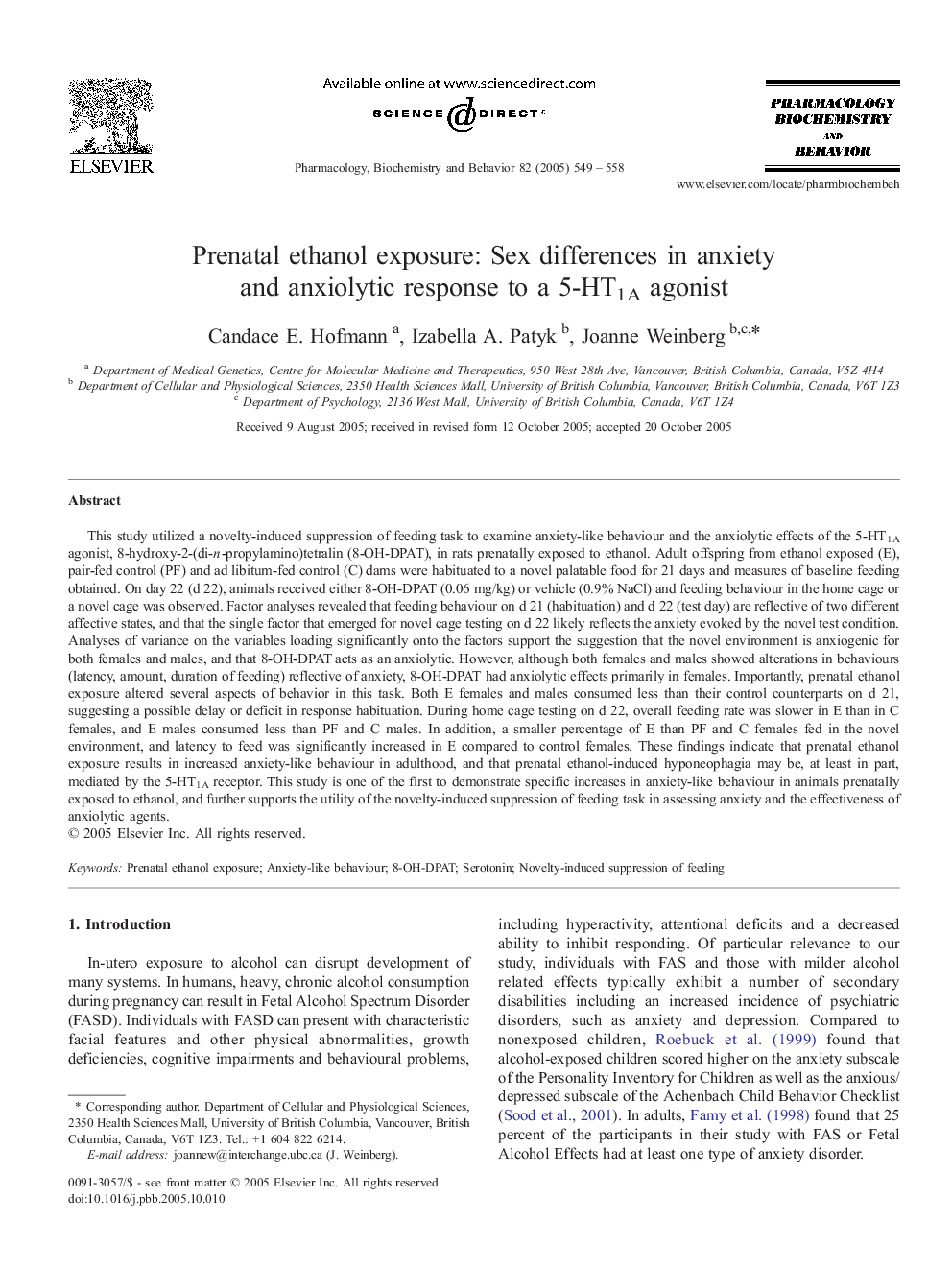| کد مقاله | کد نشریه | سال انتشار | مقاله انگلیسی | نسخه تمام متن |
|---|---|---|---|---|
| 10838346 | 1067153 | 2005 | 10 صفحه PDF | دانلود رایگان |
عنوان انگلیسی مقاله ISI
Prenatal ethanol exposure: Sex differences in anxiety and anxiolytic response to a 5-HT1A agonist
دانلود مقاله + سفارش ترجمه
دانلود مقاله ISI انگلیسی
رایگان برای ایرانیان
کلمات کلیدی
موضوعات مرتبط
علوم زیستی و بیوفناوری
بیوشیمی، ژنتیک و زیست شناسی مولکولی
زیست شیمی
پیش نمایش صفحه اول مقاله

چکیده انگلیسی
This study utilized a novelty-induced suppression of feeding task to examine anxiety-like behaviour and the anxiolytic effects of the 5-HT1A agonist, 8-hydroxy-2-(di-n-propylamino)tetralin (8-OH-DPAT), in rats prenatally exposed to ethanol. Adult offspring from ethanol exposed (E), pair-fed control (PF) and ad libitum-fed control (C) dams were habituated to a novel palatable food for 21 days and measures of baseline feeding obtained. On day 22 (d 22), animals received either 8-OH-DPAT (0.06 mg/kg) or vehicle (0.9% NaCl) and feeding behaviour in the home cage or a novel cage was observed. Factor analyses revealed that feeding behaviour on d 21 (habituation) and d 22 (test day) are reflective of two different affective states, and that the single factor that emerged for novel cage testing on d 22 likely reflects the anxiety evoked by the novel test condition. Analyses of variance on the variables loading significantly onto the factors support the suggestion that the novel environment is anxiogenic for both females and males, and that 8-OH-DPAT acts as an anxiolytic. However, although both females and males showed alterations in behaviours (latency, amount, duration of feeding) reflective of anxiety, 8-OH-DPAT had anxiolytic effects primarily in females. Importantly, prenatal ethanol exposure altered several aspects of behavior in this task. Both E females and males consumed less than their control counterparts on d 21, suggesting a possible delay or deficit in response habituation. During home cage testing on d 22, overall feeding rate was slower in E than in C females, and E males consumed less than PF and C males. In addition, a smaller percentage of E than PF and C females fed in the novel environment, and latency to feed was significantly increased in E compared to control females. These findings indicate that prenatal ethanol exposure results in increased anxiety-like behaviour in adulthood, and that prenatal ethanol-induced hyponeophagia may be, at least in part, mediated by the 5-HT1A receptor. This study is one of the first to demonstrate specific increases in anxiety-like behaviour in animals prenatally exposed to ethanol, and further supports the utility of the novelty-induced suppression of feeding task in assessing anxiety and the effectiveness of anxiolytic agents.
ناشر
Database: Elsevier - ScienceDirect (ساینس دایرکت)
Journal: Pharmacology Biochemistry and Behavior - Volume 82, Issue 3, November 2005, Pages 549-558
Journal: Pharmacology Biochemistry and Behavior - Volume 82, Issue 3, November 2005, Pages 549-558
نویسندگان
Candace E. Hofmann, Izabella A. Patyk, Joanne Weinberg,